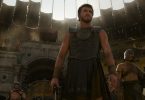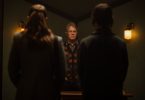No film has dominated the movie landscape in recent years than Zack Snyder’s Justice League. What was previously a mythical fantasy has turned into a reality, thanks in part to a campaign driven by the best and sometimes worst of fandom. It’s finally arrived on HBOMax, and clocking in at nearly 4-hours it’s an absolute behemoth of a film that is split between six chapters and an epilogue. Zack Snyder’s Justice League is the definitive version of the film, with plenty of new footage, a new score, different edits, and tons of other little details that bring more meaning and character to the mess we saw with 2017’s Justice League. Even at its extended length, it’s still a bloated film that suffers from trying to do too much all at once. Snyder’s version is a better film, yes, but it’s no Superman swooping in at the last minute to save the day either.
Zack Snyder’s Justice League follows the same general story of the original where the Mother Boxes have awakened, resulting in Steppenwolf traveling to Earth to find and reunite them into the Unity and turn the planet into a desolate wasteland. Batman, sensing the danger, does his best to find and recruit Wonder Woman, Aquaman, the Flash, and Cyborg to team up and face this new fear together as Superman would have wanted. But even united together, the five of them might not be enough to stop the impending invasion.
The first thing to notice about Snyder’s cut of the film is how much of the story is dedicated to establishing these characters. The majority of its 4-hour running time is focused on the front end of the film as Batman is researching and recruiting the other members. Ray Fischer’s Cyborg benefits the most from the new footage and feels like a completely different character. In 2017’s Justice League he was mostly relegated to the background and only showed up when technology needed to be hacked or the Mother Boxes broken up. Zack Snyder’s Justice League finally does his character justice, exploring how Victor Stone became Cyborg and diving deep into the complex relationship between him and his father, scientist Silas Stone. You could honestly make an entire Cyborg origin story film using the footage. That’s how much was originally left on the cutting room floor.
All of the Justice League characters receive the expanded story treatment too. The Flash has a wonderful debut in a scene where he rescue’s Iris West from a car crash. Aquaman speaks with Willem Dafoe’s Vulko over him taking his rightful place on the throne as heir to Atlantis. Wonder Woman searches for answers about the incoming invasion. There’s just a lot more story. It contributes some much needed depth and character development to the film, but more doesn’t necessarily mean better all the time though. There are still plenty of things that could have been edited down or cut completely as the film does not need to be 4 hours long. I don’t need to see all these different landscape shots of Bruce Wayne traveling to the remote village to speak with Aquaman. I also don’t need a quick cut montage of Wonder Woman making a torch out of a wooden post and some cloth. Overall the film benefits from its extended running time, but it still can feel like a slough, especially in the first half.
One of the other big changes to the film is the debut of Darkseid, played by Ray Porter. He’s the big bad of the DC Universe and is the one who is ultimately pulling the strings and wants to conquer Earth. Snyder’s cut actually changes the initial invasion of Earth to be Darkseid rather than Steppenwolf. Unfortunately, the main plot of the film is still Steppenwolf gathering the Mother Boxes and conquering the planet for Darkseid in an effort to redeem himself from his banishment. I’m actually not clear on why Steppenwolf was banished in the first place, and this is one of the areas where I feel that Snyder’s version is actually worse than the original. His banishment makes sense in the original since he failed to conquer Earth the first time, but since this film has Darkseid himself failing the initial invasion, it doesn’t provide any other explanation for why Steppenwolf has been banished other than some vague reference to betraying Darkseid. Steppenwolf was a throwaway villain in 2017’s Justice League, and he remains a throwaway villain here, albeit with a literal new coat of armor. And to be honest, Darkseid isn’t much better as he’s regulated to the background for most of his short screen time, save for a few moments where he demonstrates his powers. Steppenwolf is in constant communication with Darkseid, speaking through the Mother Boxes to his emissary DeSaad. Darkseid still feels like a tease, only he’s actually visible instead of only being mentioned by name. Steppenwolf is still very much the main villain of the film.
What makes Zack Snyder’s Justice League so interesting is seeing all the changes that were made from the theatrical version of Justice League, with the black suited Superman being one of the biggest. The addition of another “Flight” scene will definitely send chills down your spine, and the first confrontation between him and the rest of the Justice League is still as awesome as before. It’s interesting to differentiate which shots are from Zack Snyder and which ones were from Joss Whedon since they’re now completely removed. There’s still some humor throughout the film, but it’s definitely a more somber and dramatic affair this time around, especially with its excellent score from Junkie XL. The expanded story purposefully adds to the emotional development of the film and gives the characters a greater purpose and meaning.
That being said, Zack Snyder’s Justice League isn’t immensely better than the theatrical version. The main problem both films suffer is that they’re trying to do too much all at once. Snyder’s cut fairs better since it’s twice as long, but there are still problems with it. As I mentioned earlier, there’s enough content for an entire standalone Cyborg film. Even with 4 hours to work with, there are still plenty of things that feel rushed. This isn’t a problem with the directing, it’s a problem with Warner Bros. rushing out a Justice League film without putting in the time and films to actually set up the team. You can’t have a proper payoff without the setup unfortunately. Just having more isn’t necessarily better, and the film is a prime example of that.
Overall, Zack Snyder’s Justice League feels more like an extended edition of 2017’s Justice League. It’s better than that film, but the bar is set so incredibly low that it’s not saying much. I loved how Cyborg finally gets the story his character deserves. I love Junkie XL’s score, which just fits the film’s tone much better. I love the Epilogue, which teases a vision of what the future of the DC Extended Universe could possibly look like should it have a future. At the same time, there are moments where I felt simply exhausted watching the film. Superhero films shouldn’t be exhausting to watch. In the end, it’s the story behind the creation of Zack Snyder’s Justice League that is far more interesting than the film itself.
-
Zack Snyder's Justice League
Summary
No film has dominated the movie landscape in recent years than Zack Snyder’s Justice League. What was previously a mythical fantasy has turned into a reality, thanks in part to a campaign driven by the best and sometimes worst of fandom. It’s finally arrived on HBOMax, and clocking in at nearly 4-hours it’s an absolute behemoth of a film that is split between six chapters and an epilogue. Zack Snyder’s Justice League is the definitive version of the film, with plenty of new footage, a new score, different edits, and tons of other little details that bring more meaning and character to the mess we saw with 2017’s Justice League. Even at its extended length, it’s still a bloated film that suffers from trying to do too much all at once. Snyder’s version is a better film, yes, but it’s no Superman swooping in at the last minute to save the day either.







